Detailed Beginners Guide to Keto Diet [Meal Plan Included]
Thanks to Silicon Valley trendsetters, actors, and health sites the keto diet has gained tremendous popularity.
But this is for a reason as the keto diet is more than merely a quick way to lose weight:
But this is for a reason as the keto diet is more than merely a quick way to lose weight:
- It lowers blood sugar
- It burns the excess body fat without cravings
- It helps to relieve diseases like type 2 diabetes
- It acts as a natural nootropic and gives a mental edge
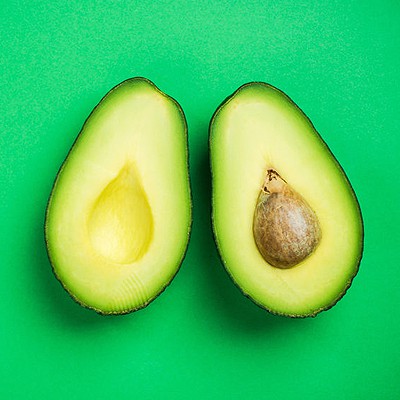
Keto diet has always been around, but thanks to its popularity it’s often advertised as a fad and a weight loss wonder without understanding how and why it works.
There’s a lot of competing and contradictory information out there with all the cheap sales pages trying to sell you the next fat loss pill.
It can be tough to cut through the hype.
That’s why I created this detailed beginners guide to the keto diet - where I will cover everything keto from A to Z, and show you the science behind it.
PS! At the end you will also find a quick start guide on “how to get started” and dead simple keto meal plan to enter ketosis in no time.
Lets “keto” in.
Keto Diet 101
What is the Keto Diet?
The ketogenic diet is, by definition, a low-carbohydrate, moderate-protein, and high-fat diet. The term "ketogenic" means "to generate ketones." So, the ketogenic diet is a ketone-generating diet. This is what sets it apart from all other low-carb diets.
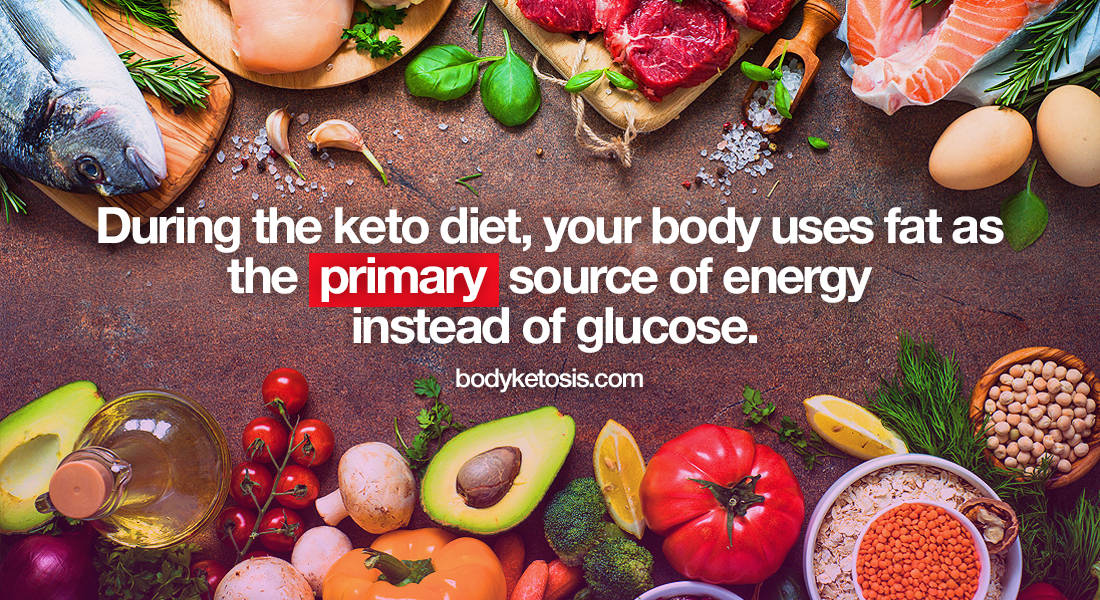
- In the clinical setting, this diet is used as an epilepsy remedy. Outside the clinical setting, it is a popular weight-loss and health-promoting eating plan.
- Researchers are studying the potentials of this diet beyond seizure control, and, so far, the results seem promising [2].
The metabolic state of enhanced ketone generating on a ketogenic diet is called nutritional ketosis. This metabolic state can only happen when you restrict carbohydrates to fewer than 50g per day and keep your protein intake moderate.
Being in ketosis comes with a plethora of well-documented health benefits like epilepsy control mentioned earlier but also weight-loss, diabetes control, cancer-fighting, brain health, and more [2].
8 Types of Keto Diets
When talking about keto, most refer to a popularized standard version or the original version designed by Dr. Wilder. There are, however, many other versions, some used in the clinical setting, others outside it.
Keto diets in clinical use
- Classical Ketogenic Diet (CKD) - This is the original version developed in the 1920s. It has a 4:1 or 3:1 ratio of fat to protein and carbs. On the CKD, 90% of calories come from fat, 6% from protein, and 4% from carbs. CKD is also highly individualized.

- MCT Ketogenic Diet - The MCT keto diet was developed in the 1970s. This version is supplemented with MCT oil since MCTs produce ketones more easily than other fats, allowing for greater intake of carbs and protein.
- Modified Atkins Diet (MAD) - A modified version of Atkins used to treat epilepsy, MAD is less restrictive than classical keto, allowing for unlimited amounts of protein and fat. It is also less strict about food measuring and recipes.
- Low Glycemic Index Treatment (LGIT) - Another diet used to treat epilepsy, the LGIT allows for more carbohydrates than classical keto (40-60g). However, all carbs need to be low-GI.
Keto diets in popular use
- Standard Ketogenic Diet (SKD) - Not to be confused with classical keto, this popular keto version is what most people today follow. It is based on a macronutrient ratio that is roughly 75% fat, 20% protein, and 5% carbs.
- Cyclical ketogenic diet (CKD) - Popular among athletes and people struggling with carb restriction, the CKD involves cycling between the SKD and periods of higher-carb refeeds. Usually, it involves following the SKD for 5-6 days and carb refeeds on days 6 and/or 7.
- Targeted ketogenic diet (TKD) - On the TKD, you target the time you eat carbs, and this is usually around workouts. However, your daily allowance is the same as on the SKD.
- High-protein ketogenic diet - Everything is the same as standard keto but with more protein, usually making up 35% of daily calories. This version is best for bodybuilders.
Keto Macronutrients
The keto macronutrient ratio is the cornerstone of the keto diet. It is the ratio of grams of fat to grams of carbohydrate plus protein. The higher this ratio, the greater the degree of ketosis [3].
Typically, this ratio is either 4:1 or 3:1. The macronutrient ratio of a keto diet is also broken down as follows: 5-10% carbs, 15-30% protein, and 60-75% fat.
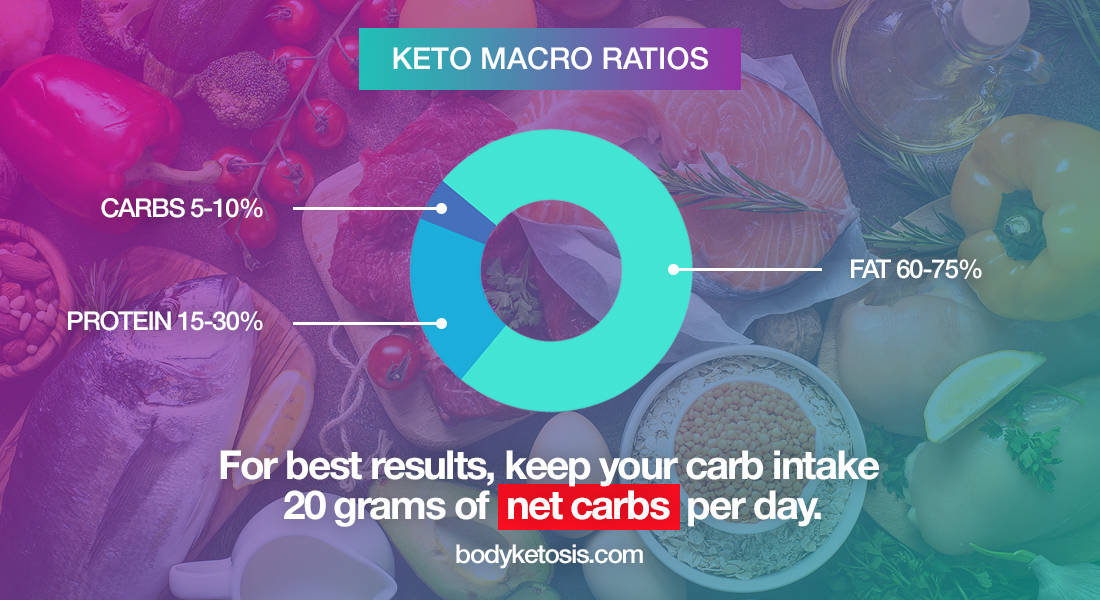
No matter how many calories you eat, your net carb intake always needs to be below 50g per day, and ideally 20g per day. Net carbs are grams of total carbs minus grams of fiber.
The reason we calculate net rather than total carbs is that net carbs have an effect on blood glucose.
Moderate protein intake is another caveat of the keto ratio. Your body converts dietary protein into glucose when you restrict carbs to prevent low blood sugar levels. However, too much of protein can raise your blood sugar high enough to prevent ketosis [4].
A higher macros ratio will give you quicker and greater results, but it will also cause greater side effects and make the diet difficult to follow. For long-term success and sustainability, a moderate ketogenic ratio works best.
Keto, Atkins & Paleo
You'll often see headlines lumping keto in together with other low-carb plans. But it's important to understand that keto diet and low-carb diet aren't the same. There is one major difference that is ketosis.
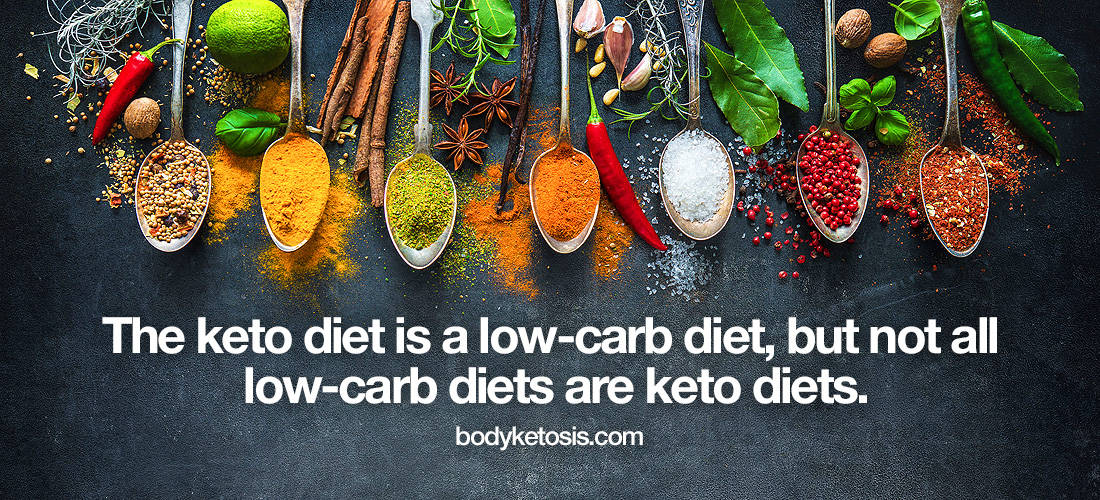
- The ketogenic diet is not just a low-carb diet, it's a very-low-carbohydrate diet (VLCD). Carbs on this diet are so low that the body cannot rely on them for energy anymore, so it switches from a metabolic state of burning carbs to burning fats,a.k.a. ketosis.
- Other low-carb diets include the Atkins nutritional approach, the Dukan Diet, the paleo diet, the Whole30 diet, and the zone diet. But none of these diets have an effect on fat metabolism as dramatic as keto.
That isn't to say that other low-carb diets are without any benefits. Most are easier to maintain than keto, and they can be good enough for things like moderate weight loss and blood glucose control.
You'll often see the keto diet being lumped in together with other low-carbohydrate diets like Atkins and paleo. However, there are major differences in the nature and purpose of these three diets:

- Keto - The keto diet is a low-carbohydrate diet that leads to nutritional ketosis. Such a diet also relies on variable amounts of fat and protein to work. The central feature of keto is its macronutrient ratio.
- Atkins - Also called the Atkins nutritional approach, the Atkins diet is a low-carb eating plan designed for weight loss and that does not rely on ketosis. The diet is carried out in roughly 4 phases, with the last phase reintroducing a moderate intake of low-GI carbohydrates.
- Paleo - The Paleolithic (paleo) diet is a diet based on what our ancestors supposedly ate some 12.000 years ago. Paleo excludes refined and highly processed foods and even all grains and legumes. Paleo does not cause nutritional ketosis.
History of the Keto Diet
The ketogenic (keto) diet is one of the latest eating plans endorsed by celebrities like Halle Berry, LeBron James, and Kourtney Kardashian. However, this diet isn't really all that new. In fact, it has been around for almost a whole century.
The history of the keto diet began back in 1921 when Dr. Russell M. Wilder at the Mayo Clinic used it to treat childhood epilepsy [1]. He also coined the term "ketogenic diet." The diet proved to be effective and has been used throughout the 1920s and 30s as an epilepsy treatment.
But with the advent of anti-epileptic drugs in the 1940s, keto fell out of use. Despite that, interest in the potentials of this diet continued to grow and the diet went through a resurgence with the turn of the century.
Nowadays, people are using keto to lose weight, manage diabetes, increase performance, and prevent illness. The number of published studies on this diet has also grown from less than a dozen to over forty a year [1].
Ketosis 101
What is Ketosis?
Ketosis is a normal metabolic state in which a portion of your body's energy comes from ketones. Ketosis happens when the body metabolizes fat at a greater rate than normal and turns fatty acids into ketones.
Drops in blood sugar typically trigger ketosis because the brain relies on a constant influx of glucose to survive. However, many other organs can also use ketones for energy, notably the heart, skeletal muscles, and kidneys.
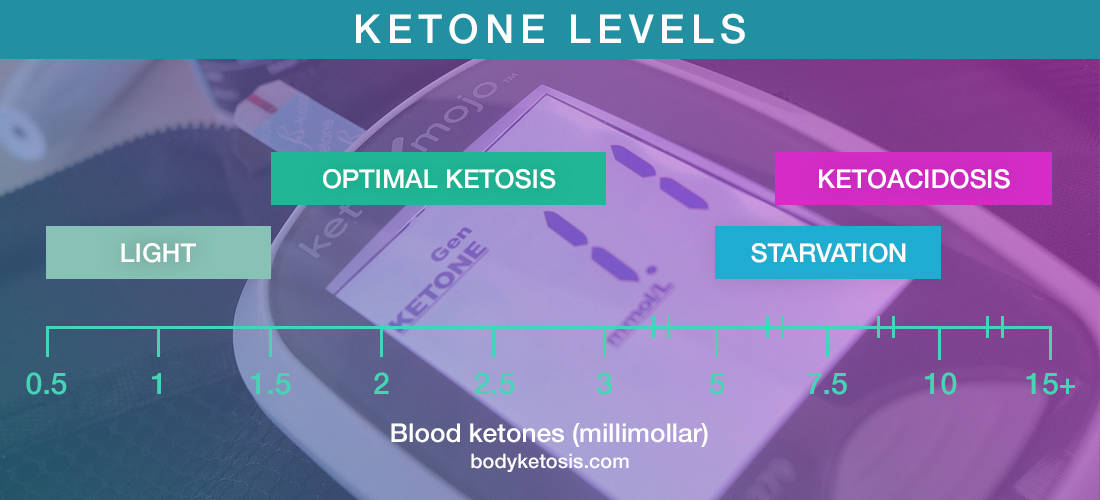
Blood glucose levels can become low for a range of reasons. A common reason is an overnight fast. Less common are prolonged fasting, starvation, and eating fewer than 50g carbohydrates.
Ketosis can be measured with urine, blood, and breath tests. The most accurate way to measure ketosis is by checking how many ketones are in the blood.
A reading of 0.5 to 3mM is considered healthy for people on keto diets. Levels above that could be dangerous, especially for diabetes patients.
What are Ketone Bodies?
Ketone bodies, commonly called ketones, are simple molecules that replace glucose as fuel during ketosis.
There are three types of ketones produced during ketosis: Acetoacetate, β-hydroxybutyrate and Acetone.
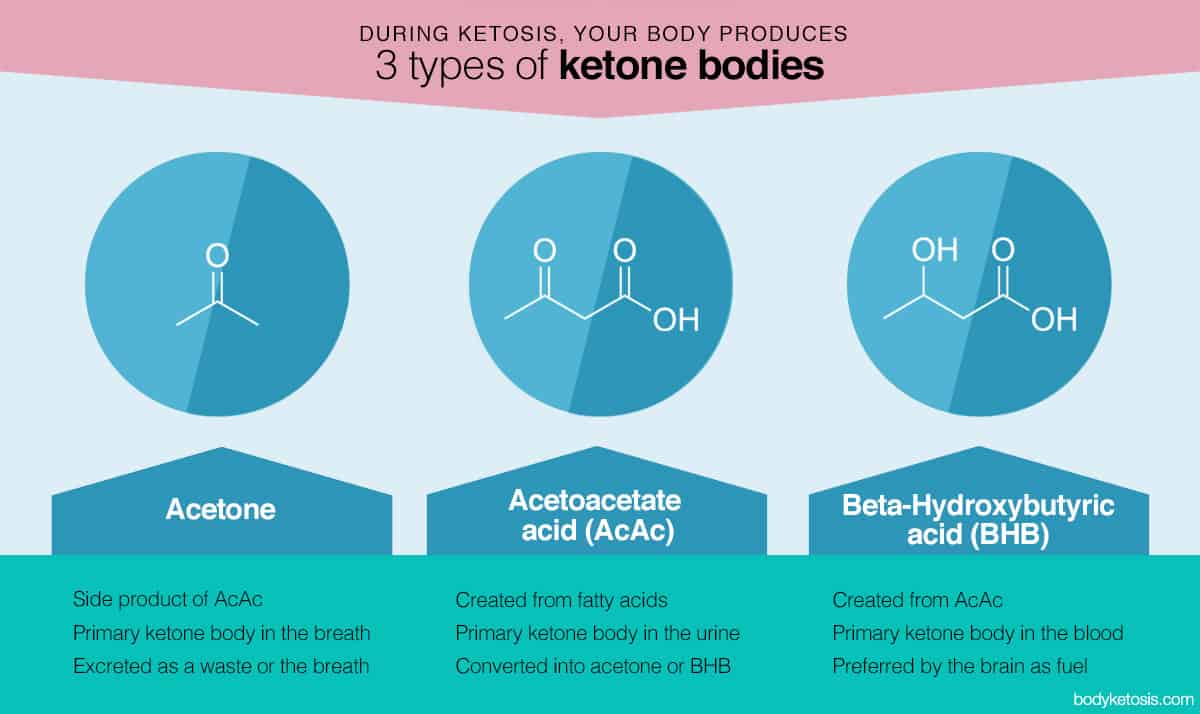
- The body makes acetoacetate first, converts it into β-hydroxybutyrate (BHB), which accounts for 70% of ketones supplying energy during ketosis [5].
- Acetone is a by-product of ketosis that exits the body through the lungs. It is the main cause of keto breath and smells like fruit or nail polish remover.
- Of the three ketone bodies, BHB is the most metabolically active. Interestingly, it's not a ketone body from a molecular point of view, but a hydroxyl-acid. It's called a ketone body because it is produced during ketosis.
A lot of people think that the body makes ketones only when starving or on a keto diet. In truth, your body makes a small number of ketones all the time.
After an overnight fast, ketone bodies supply 2–6% of the body's energy, while they supply 30–40% of the energy after a three-day fast [6]. On a keto diet, they can supply 70% of the brain's energy.
Ketoacidosis vs. Ketosis
Many dieters and health professionals alike tend to confuse the completely natural state of ketosis with a life-threatening state of ketoacidosis.
- Ketosis is when the body is producing ketones to make up for a lack of glucose. It is an adaptive response that evolution designed to help us survive starvation. The ketogenic diet upregulates this metabolic state.
- Ketoacidosis, on the other hand, is a buildup of ketones in the blood usually caused by untreated type 1 diabetes but sometimes also type 2 diabetes and alcoholism. This buildup can be over tenfold higher than normal and make the blood acidic, which can cause coma or even death.
The main reason people develop ketoacidosis is because they lack insulin, and insulin helps regulate ketone body production. People often confuse ketosis with ketoacidosis because both involve ketones. However, the difference is huge and that of degree.
The ketogenic diet does not lead to ketoacidosis for healthy individuals when balanced and has been a safe therapy for children for decades. However, an unbalanced and extreme keto diet can become a risk for ketoacidosis in some cases [7].
How to Get Into Ketosis?
There are two ways to induce ketosis: through fasting or low-carb diets like keto. Keto can help you achieve long-term ketosis and is also the safest way to reach this metabolic state. Here are the steps to follow keto correctly for ketosis:
- Reduce carb intake - Most people can reach ketosis on 50g of net carbs per day. If your ketone test results show you're not in ketosis after eating this much for a whole week, then lower your intake up to 20g daily.
- Increase fat intake - Make sure that up 60-75% of your daily calories are from fat. On a 2.000 ketogenic diet, that’s 1.200-1.500 calories from fat or roughly 130-160g of fat daily.
- Eat moderate amounts of protein - Moderate protein intake is anywhere between 1 and 2g per kg of body weight [8]. If you're very active, then feel free to eat within the upper limit. If not, then a lower intake will do.
- Drink plenty of fluids - In the first stages of ketosis, you will be pee more than usual, so staying hydrated is key. Frequent urination during ketosis is a result of glycogen depletion as glycogen is 3-4 parts water.
- Take electrolytes - Electrolyte imbalances frequently accompany water loss [9] and cause symptoms of the keto flu. Electrolytes you need to supplement in the first weeks of keto include sodium, magnesium, potassium, and calcium.
- Exercise - You don't need to break a sweat to get into ketosis but working out makes the transition quicker. Studies show that exercise raises ketone levels and that the ability to use ketones is greater in exercise-trained muscles [10].
- Take MCTs - Medium-chain triglycerides (MCTs) are sold as supplements in oil form. They speed up the time it takes to get into ketosis and even reduce symptoms of the keto flu according to new studies [11].
How Do I know that I'm in ketosis?
When you begin entering ketosis, you will likely experience the following signs and symptoms:
- Keto breath
- Reduced hunger
- Weight loss
- Increased focus
- More energy
- Flu-like symptoms
Some of these are the result of having greater ketone levels, others from fluid and electrolyte imbalances. Once you become keto-adapted, you can expect the more uncomfortable symptoms to taper off.
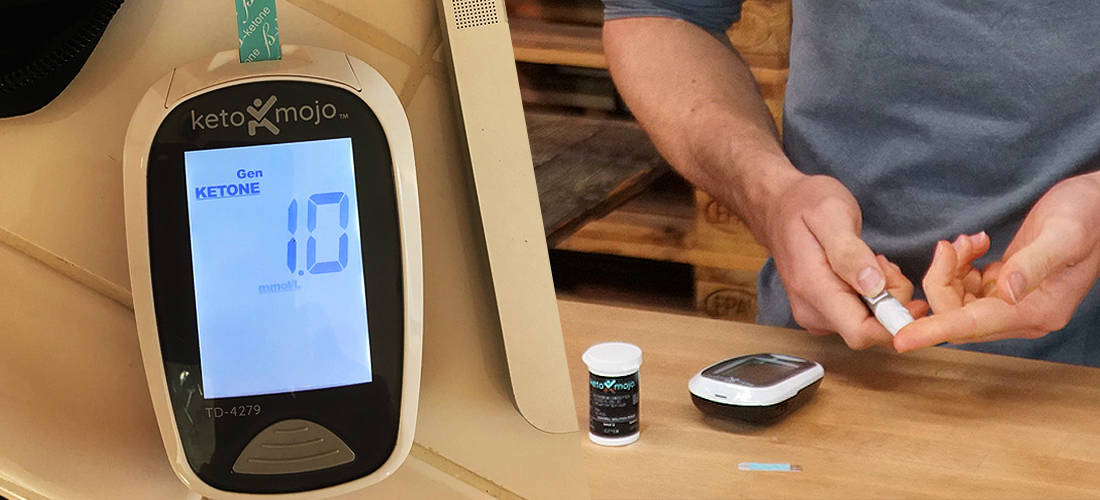
Besides checking for obvious ketosis symptoms, there are ways to test for ketosis:
- These test for acetoacetate in urine. They're cheap, easy to use, and non-invasive. However, they are the least accurate of all ketone testing methods.
- A study published in Diabetes & Metabolism found that results from urine test strips don't correlate with blood ketone values in deep ketosis and ketoacidosis [12].
- Despite not showing accurate levels of ketones, they great for testing if you're in ketosis or not. You can use them when just starting a keto diet to see if you're on the right track.
- Also called keto breathalyzer, these devices measure for acetone in the breath. Studies found breath ketone testing is quite accurate [13].
- It is also affordable, portable, and easy to do. Simply blow into this device and check the reading on its digital display.
- What's great is that breath ketone meters monitor changes in ketosis almost instantly. They're best if you're looking for a somewhat precise but cheap way to test ketone levels.
- The most accurate way to test for ketone levels. Unfortunately, it is also expensive and invasive. These devices measure BHB – the most metabolically active and most numerous ketone body.
- Blood ketone meters may also measure blood glucose in addition to blood ketones – perfect if you're using the keto diet to manage diabetes.
- Keep in mind that you will be buying test strips to use with this meter.
Keto and Weight Loss
Okay I get it, keto helps with different health conditions, but why it's so effective for weight loss?
Studies show that keto leads to greater long-term weight-loss than other diets [14]. There are three reasons why this is the case:
- Greater fat burning - All weight-loss diets lead to fat burning, but not to the same extent as keto. Ketogenic diets deprive the body of its preferred fuel source – carbohydrates. Without enough carbs in your diet, the body has no other choice but to burn fat instead.
- Reduced hunger - An interesting thing about keto is that it suppresses hunger, leading dieters to eat less. Researchers suggest that a lower appetite on keto may directly have to do with ketosis and ketones [15]. Balanced blood glucose on a keto diet may also be the reason behind this.
- Greater calorie spending - Being in ketosis is costly, using a great deal of energy to maintain. Researchers believe that gluconeogenesis alone spends 400-600 calories daily [16].
Benefits
While keto was originally designed as an epilepsy protocol and later became a weight loss diet, it turns out it comes with a whole array of many other benefits:
- Neurological health - Besides epilepsy, keto can help with Alzheimer's, Parkinson's, autism, depression, brain cancer, brain injury, and simple mental fatigue [20, 21].
- Blood glucose - As already explained, keto is a great way to manage blood sugar for those with diabetes and pre-diabetes.
- PCOS - Studies show that low-carb diets like keto help manage polycystic ovary syndrome (PCOS) through weight loss and by lowering insulin [22].
- Fatty liver - There is some evidence that keto can be useful as a treatment for non-alcoholic fatty liver disease [23, 24].
- Cardiovascular health - Low-carb diets like keto were found to improve blood lipids, blood sugar, blood pressure, and other factors involved in cardiovascular health [25].
- Acne - Acne can be a result of elevated insulin, inflammation, oxidative stress, and the ketogenic diet can help address all these issues for clearer skin [26].
- Cancer - Most cancer cells cannot use ketones to proliferate, so keto may be a feasible adjuvant therapy for some cancers [27].
- Workout performance - There's evidence that keto-adapted athletes are better able to burn fat and utilize ketones during workouts than athletes not on keto diets [28].
- Well-being - The ketogenic diet can improve your physical and mental well-being by improving many aspects of your health that may not have been optimal.
Side-effects
The keto diet is a radical shift from how you normally eat. It also completely transforms how your metabolism works. Adjusting to such big changes can challenge your body, so you may experience symptoms as a result.
Luckily, most keto diet side effects are temporary. Common side effects to expect include:
- Fatigue
- Nausea
- Constipation
- Diarrhea
- Headaches
- Muscle cramps
- Insomnia
- Keto breath
- Weakness
- Keto rash
Most of these symptoms are a result of fluid and electrolyte imbalances and are collectively termed "keto flu [29]." Most also tend to resolve within a few days or a few weeks.

However, some of these symptoms are a reaction to ketones (keto rash) and to changing glucose levels (insomnia)
Preventing and treating the keto flu is easy. Just consider taking the following steps:
- Take plenty of fluids - Water, soup, vegetables, fruit, smoothies, keto coffee, and other liquid-containing foods account for your daily water intake. The recommended daily fluid intake is 2,200 for women and 3,000 for men [30]. However, you may need to take more on keto and if exercising.
- Take electrolytes - You can get the electrolytes you lose from food and supplements. Sources of electrolytes include nuts, seeds, avocados, spinach, salmon, coconut water, table salt, bouillon cubes, and mineral water.
- Slowly reduce carbs - A gradual reduction in carbs will lead to milder side effects than if you go in head first. Hidden carbs may also be a problem because they're not letting you fully go into ketosis, so do pay attention to these as well.
- Take supplements - MCT oil is proven to reduce the side effects of keto induction [11]. Another supplement found to help with the keto flu is exogenous ketones [31].
Keto is Not For Everyone
Keto works well for most healthy individuals, but if you have a health condition then you should probably consult with your healthcare professional.
People with the following conditions to some extent can follow keto but ONLY with doctors approval and supervision.
- Overweight and obese - Researchers are seriously considering recommending the keto diet to treat obesity [17]. So, if you're struggling to lose weight, you may also want to consider giving this diet a try.
- Type 2 diabetes - After one year on a keto diet, 349 adults with type 2 diabetes reduced their A1C to 6.3 percent, lost 12% of their weight, took less diabetes medication, and their need for insulin dropped by 94 % [18].
- Type 1 diabetes - Keto can also help lower blood glucose and HbA1c in those with type 1 diabetes [19]. However, you also need to adjust your insulin medication to avoid hypoglycemia.
- Neurological conditions - There is evidence keto can be effective for adult epilepsy, some brain tumors, psychiatric disorders, autism, and migraines [20].
PS! Before starting any drastic dietary changes, we always suggest consulting with your healthcare professional first.
People who should not follow keto include
- Pregnant and breastfeeding - Pregnancy is not the time to follow a fat-burning diet since everything during this time is geared towards fat gain. Eating low-carb while breastfeeding may also put women at risk of ketoacidosis.
- If you're underweight - This one goes without saying. The ketogenic diet may not lead to weight loss if you eat enough calories, but the risk is still there.
Also, those with the following conditions should also avoid the keto diet:
- History of pancreatitis and kidney failure
- Gallbladder disease
- Abdominal tumors
- Carnitine deficiency
- Fat metabolism disorders
- Porphyria
What to Eat and Drink
Keto Foods
There are foods you can eat and foods you need to avoid in order to achieve a balanced ketogenic diet that has the right balance of keto diet macros while also being rich in key nutrients.
What to eat on a keto diet
- Meat: Minced beef, ribeye steak, pork belly, pork chops, chicken thighs, ham, bacon, and fatty cuts of meat in general.
- Fish: Salmon, sardines, mackerel, herring, trout, and tuna are all fatty fish rich in omega-3s you need to have in your diet.
- Dairy: If you can tolerate dairy, go for full fat like heavy cream, yogurt, cream cheese, and butter.
- Eggs: Go for free-range whenever possible and make sure to eat the yolk, since that's where all the fat is at.
- Nuts and seeds: Walnuts, macadamia nuts, hazelnuts, almonds, sesame seeds, flax seeds, chia seeds, and sunflower seeds are all good options.
- Oils and fat: Olive oil, coconut oil, sesame oil, ghee, lard, tallow, and other unrefined fats to cook and bake with are a must.
- Low-carb vegetables: Collard greens, cruciferous vegetables, zucchini, eggplants, peppers, green beans, and asparagus are just some examples of the many veggies you can eat on keto.
- Low-carb fruit: Stick to berries and use lemon and lime sparingly.
- Nut flours: Coconut and almond flour are keto baking staples but go for other nut flours if you prefer.
- Nut milks: Almond and coconut milk are used instead of dairy milk on a keto diet, which is high in lactose.
- Nut butters and tahini: A convenient way to add both fat and protein when needed.
- Herbs and spices: Dried herbs, pepper, smoked paprika, and similar are great to flavor keto meals.
- Low-carb condiments: Mayonnaise, mustard, vinegar, ranch dressing, and coconut aminos.
- Sugar substitutes: Stevia, erythritol, monk fruit, and other non-nutritive sweeteners to replace sugar in your keto desserts.
What to avoid on a keto diet
- Cereal grains: wheat, barley, rice, millet, oats, corn, and products made from these. Also, avoid pseudocereals like quinoa and buckwheat.
- Legumes: Beans, peas, lentils, chickpeas, and soy.
- Starchy vegetables: Parsnips, carrots, potatoes, beetroot, and yams.
- High-carb vegetables: Onions, leeks, butternut squash, and similar vegetables should either be avoided or used sparingly.
- Most fruit: Avoid bananas, apples, peaches, watermelon, and most fruit.
- Nutritive sweeteners: Sugar, honey, and maple syrup are mostly carbs, so avoid them at all costs.
- High-carb condiments: ketchup, balsamic vinegar, BBQ sauce, and sweet and sour sauce are just a few examples.
Keto Drinks
Staying hydrated is important. But be careful with what you drink on a keto diet since many drinks we think are low-carb are the exact opposite. When in doubt, go for plain water. Otherwise, follow the tips below.
Drinks allowed on keto
- Water: Including mineral, lemon water, and mineral water.
- Plain coffee: Don't add sugar or creamer to your coffee. Instead, make plain or keto coffee.
- Tea: Unsweetened tea and herbal teas are ok on keto.
- Keto smoothies: You will find many low-carb recipes to make this breakfast staple.
- Diet coke: Although not healthful, diet coke has zero carbs in it.
Drinks not allowed on keto
- Juices: All fruit juices, including orange juice, apple juice, and grapefruit juice. Also, avoid green juices since they have more carbs than whole vegetables.
- Sugar-sweetened beverages: Not allowed for obvious reasons on a keto diet.
- Milkshakes: You can make keto-friendly milkshakes at home; otherwise, avoid the restaurant stuff.
What about alcohol?
Some alcoholic beverages are low in carbs, others not so much. But even low-carb beverages can be a problem on keto since alcohol interferes with ketosis. If you choose to drink alcohol on your keto diet, prefer hard liquor.
Keto friendly alcoholic drinks
- Spirits: Vodka, tequila, whiskey, and other spirits have barely any carbs.
- Dry wines: Sauvignon Blanc, Pinot Blanc, and Chardonnay are just some examples.
- Light beers: Bud Select and Michelob ultra are good examples.
High-carb drinks to avoid
- Liqueurs: These generally have too much sugar to be keto-friendly. Examples include Baileys, Carolans, and cherry liqueur.
- Dessert wines: Moscato, Rose, and Moscatel have a sweet taste because of their higher sugar content than dry wines.
- Dark beer: Generally speaking, dark beer is higher in carbs than light beer.
- Cocktails: Most have added sugar in them, but keto-friendly versions also exist.
Supplements
Supplements make meeting nutritional needs easier, but they're not really necessary (not all of them). A well-balanced keto diet can get you all the nutrition you need to stay healthy and in ketosis. Still, there are keto supplements that make this diet a whole lot easier and simpler.
So, what are keto supplements?
Keto supplements are products that contain nutrients and compounds that support ketosis. Many manufacturers also to make their products as healthy as possible because their customers tend to be health conscious.
Examples of some of the most popular keto supplements include:
- Exogenous ketones - Most exogenous ketones on the market are ketone salts. They are synthetic ketones bound to minerals like sodium, calcium, or magnesium. Studies show they effectively raise blood ketone levels [32]. They're best used to make transitioning into ketosis easier and correcting diet mistakes like overeating on carbohydrates.
- MCTs - MCT oil is a keto diet staple that also makes getting into ketosis much easier and provides many other benefits. It's a quality fat source that's essential in the keto kitchen. However, you can also find MCT sold as pills, powders, MCT creamers, MCT bars, and other products.
- Electrolytes - Keto experts recommend taking 3-5g of sodium, 3-4mg of potassium, and 300-500mg of magnesium daily on a keto diet. Because obtaining these from food can be tough for some dieters, electrolyte supplements make for a failproof and convenient way to curb imbalances.
- Other supplements - Some dieters also include collagen peptides, protein powders, digestive enzymes, and fiber supplements on this diet.
Exercise on Keto
Most weight-loss and health protocols recommend exercising. That's because exercise burns calories and helps preserve muscle mass. With preserved muscle mass, you also won't experience drops in your resting metabolic rate (RMR) – the rate at which you burn calories at rest.

Keto is different. One study involving 20 obese patients found that after four months, the diet caused fat loss and no loss of muscle mass [33]. Another study found that the diet did not cause a drop in RMR [34].
And while you don't need exercise to lose fat and maintain lean muscle on keto, it's a good idea to include it as part of your weight-loss journey.
- Exercising helps improve insulin sensitivity, blood glucose levels, aerobic fitness, and can give you bigger muscles.
- Another point of concern with keto and exercising is if it can have a negative effect on athletes and anaerobic workouts. Short-term keto (1-3 weeks) does impair performance, and especially anaerobic workouts [35]. But long-term keto does the exact opposite [28].
So, with all that out of the way, how should you exercise on keto?
- Try light workouts to deplete glycogen - If you're in a hurry to get into ketosis, try doing some jogging, sprint walking, cycling, hiking, or strength training to deplete glycogen.
- Do aerobics weight-loss and keto-adaptation - Aerobic activities like running and swimming won't cause any harm. In fact, they may help you burn calories. In the long-run, it will help with keto-adaptation and aerobic fitness.
- Consider strength training for muscle building - Also called resistance training, strength training exercises include push-ups, squats, and weight-lifting. These workouts are necessary if you want to bulk up, but make sure to eat a bit more protein to help support muscle protein synthesis.
Common Mistakes
Mistakes are bound to happen when switching to a diet that's drastically different from your current way of eating. So, don't be hard on yourself and try to learn from your own and others' mistakes.
With that said, here are common mistakes to try not to do when starting your keto journey:
- Becoming dehydrated - A lot of keto newcomers underestimate the amount of water and electrolytes they need to be consuming. The keto diet will make you urinate more, and you risk becoming dehydrated. To counteract this, drink a gallon of water a day if needed.
- Not taking electrolytes - Your body cannot hold water without electrolytes. So, with greater fluid input and output, you'll also need more electrolytes than usual. Go for electrolyte supplements and follow the packaging directions to stay safe.
- Eating too much protein - The reason you don't experience hypoglycemia on keto is gluconeogenesis, a metabolic pathway that turns protein into glucose. But if you eat too much, it can be almost like eating lots of carbohydrates [4].
- Not eating enough fat - Fat on a keto diet will keep you full, give you calories, provide nutrients. But, most importantly, it will be the substance from which ketones are made of. Your body needs enough fat to get into ketosis.
- Eating too much fat - On the other hand, if you eat too much, you'll be in a calorie surplus. To know how much fat you should be eating, use a keto calculator. Luckily, the keto diet naturally suppresses appetite, so overeating isn’t a problem for most.
- Not measuring ketones - Test for ketosis and measure ketones early in your keto diet. This will help you gain insight into how well your diet is working; if you need to make changes, and if you're experiencing problems like high blood sugar and ketones simultaneously.
- Eating a monotonous diet - A monotonous keto diet can become dangerous. If you're not eating a variety of food, your risk of dangerous deficiencies skyrockets, and with those deficiencies, your risk of developing diseases becomes greater too.
Quick Start Guide
You've learned about the essentials of the ketogenic diet and now you're ready to jump on the bandwagon. But how exactly do you start?
Starting anything new is the most difficult part of the process. Luckily, there are steps you can take that take out all the guesswork out of keto dieting. Here are some of those steps for you to consider:
- Take before photos and take measurements - If weight loss is your goal, then take a full-body photo of yourself and measure your weight and waist circumference. This will help you track your progress and know how much exactly your diet is working.
- Make a kitchen overhaul - Empty your fridge and pantry of foods you won't be eating like pasta, rice, jam, frozen yogurt, and fruit juice. Replace these products with keto staples like avocados, bacon, butter, coconut oil, and almond milk.
- Find a simple meal plan - This is essential. Find a SIMPLE and delicious meal plan and follow it rigorously for the first week. I suggest finding 3 simple meals you enjoy and eat them every day. This will eliminate any opportunity for mistakes and hidden carbs.
- Find a stress-free period - Chances are, you'll come down with the keto flu when you first transition. To avoid having to take days off from work or make your diet an inconvenience in any other way, plan your first days of keto when you have fewer obligations.
- Start out with intermittent fasting (IF) - This is Not a mandatory step, but I suggest starting the first day of keto with IF. Basically just skip your breakfast. This will help to deplete your glucose levels, so you can enter ketosis faster.
- Cut out all carbs - Follow your keto meal plan rigorously without cheating with carbs. Cut out all carbs, and eat only loads of quality fats and protein. If needed add some MCT oil to the mix. MCT is a quality fat source that helps to ramp up your fat intake.
- Treat your keto flu - There's no reason to suffer when experiencing flu-like symptoms during carbohydrate withdrawal. Drink loads of water, get more salt in and rest. The easiest way to bypass keto flu is to take electrolyte supplements, but you can try to get those minerals separately.
- Measure your ketosis - Check if you are in mild to moderate ketosis when you start keto with ketone urine test strips. If possible, use more accurate measuring tools. If you're not reaching at least moderate ketosis by week two, then lowering your carbs further may be necessary.
Simple Keto Meal Plan
To give you an idea of how a keto diet looks like in practice, below is a sample of a 3-day keto meal plan. Feel free to use it to start the first few days of your keto journey using the meals described here.
Day 1
- Breakfast: Scrambled eggs (with cream) and a pork sausage
- Lunch: Ham and cheese rolled rolls filled with cream cheese and avocado
- Dinner: Baked trout with sautéed spinach and cauliflower rice
Day 2
- Breakfast: Baked chicken breasts with cheese and spinach
- Lunch: Lettuce-wrap sandwich (lettuce, cheddar, salami, cucumbers, and cream cheese) and egg-drop soup
- Dinner: Roast beef with arugula salad (arugula, olive oil, apple cider vinegar, salt, and pepper)
Day 3
- Breakfast: Breakfast tapas with cold cuts, Swiss cheese, cucumbers, and almonds.
- Lunch: Chicken salad from chicken breasts, spinach, avocado, bacon, hard-boiled egg, and olive oil dressing
- Dinner: Low-carb almond flour pasta with sautéed sausage, butter, and parmesan cheese

Good blog contain informative information for people.I am regularly read your articles please check this also Keto Rash
ReplyDelete